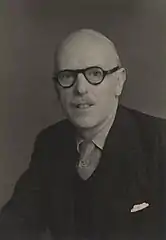T. D. Kendrick
Sir Thomas Downing Kendrick KCB FBA FSA (1 April 1895 – 2 November 1979) was a British archaeologist and art historian.[1][2]
T. D. Kendrick | |
|---|---|
 | |
| Born | 1 April 1895 |
| Died | 2 November 1979 (aged 84) |
| Nationality | English |
| Occupation | Director of the British Museum |
Notable work | A History of the Vikings (1930) |
Life
Kendrick was born in Handsworth, a suburb of Birmingham, England,[3] and educated at Charterhouse School and Oriel College, Oxford, for a year before World War I, during which he was wounded and rose to the rank of captain.
Initially specializing in prehistoric art, Kendrick turned in the 1930s to Viking and Anglo-Saxon art, for which his two survey volumes were long standard references. Kendrick was Director of the British Museum from 1950 until he retired in 1959. He believed in cleaning museum objects, but this resulted in numerous bronze artifacts in his department being overcleaned.[3] He was a keen advocate of Victorian art, with assistance from the poet John Betjeman and the painter John Piper, amongst others. Kendrick's notes on Victorian stained glass were used by Nikolaus Pevsner for his Buildings of England series (now the Pevsner Architectural Guides).[4]
Kendrick died in Dorchester, Dorset.[3]
Publications
Books
- The Axe Age: a study in British prehistory (1925)
- The Druids: a study in Keltic prehistory (1927)
- A History of the Vikings (1930)
- Anglo-Saxon Art to A.D. 900 (1938)
- The Archaeology of the Channel Islands, 2 vols. (1928–38)
- Archaeology in England and Wales, 1914–1931 (1932)
- The Presidents of the Society of Antiquaries of London: with biographical notes (1945) (with Sir James Mann)
- Late Saxon and Viking art (1949)
- British Antiquity (1950)
- The Lisbon Earthquake (1956)
- St. James in Spain (1960)
- Great Love for Icarus (1962) – a semi-autobiographical novel
- Mary of Agreda: the life and legend of a Spanish nun (1967)
Articles
- Kendrick, T. D. (June 1932). "British Hanging Bowls". Antiquity. 6 (22): 161–184. doi:10.1017/S0003598X00006700.

- Kendrick, T. D. (January 1941). "Notes: Portion of a basalt hone from North Wales". Antiquaries Journal. 21 (1): 73. doi:10.1017/S0003581500095354.
- Kendrick, T. D. (January 1941). "Notes: Gourd bottles from Sutton Hoo". Antiquaries Journal. 21 (1): 73–74. doi:10.1017/S0003581500095366.
- Kendrick, T. D. (January 1941). "Notes: Dug-out canoes in the British Museum". Antiquaries Journal. 21 (1): 74–75. doi:10.1017/S0003581500095378.
- Kendrick, T. D. (January 1941). "Notes: Fragment of a cross-head from Bath". Antiquaries Journal. 21 (1): 75–76. doi:10.1017/S000358150009538X.
References
- Wilson 2005.
- The Times 1979, p. 31.
- Kendrick, T[homas] [Downing], Dictionary of Art Historians
- Nikolaus Pevsner, The Buildings of England: Cornwall (1951), p. 9.
Sources
- Wilson, David M. (2005) [2004]. "Kendrick, Sir Thomas Downing". Oxford Dictionary of National Biography (online ed.). Oxford University Press. doi:10.1093/ref:odnb/31303. (Subscription or UK public library membership required.)
- "Sir Thomas Kendrick". The Times. 23 November 1979. p. 31.
Further reading
- "Kendrick, Sir Thomas Downing". Who's Who. doi:10.1093/ww/9780199540884.013.U156312. Retrieved 5 March 2020.